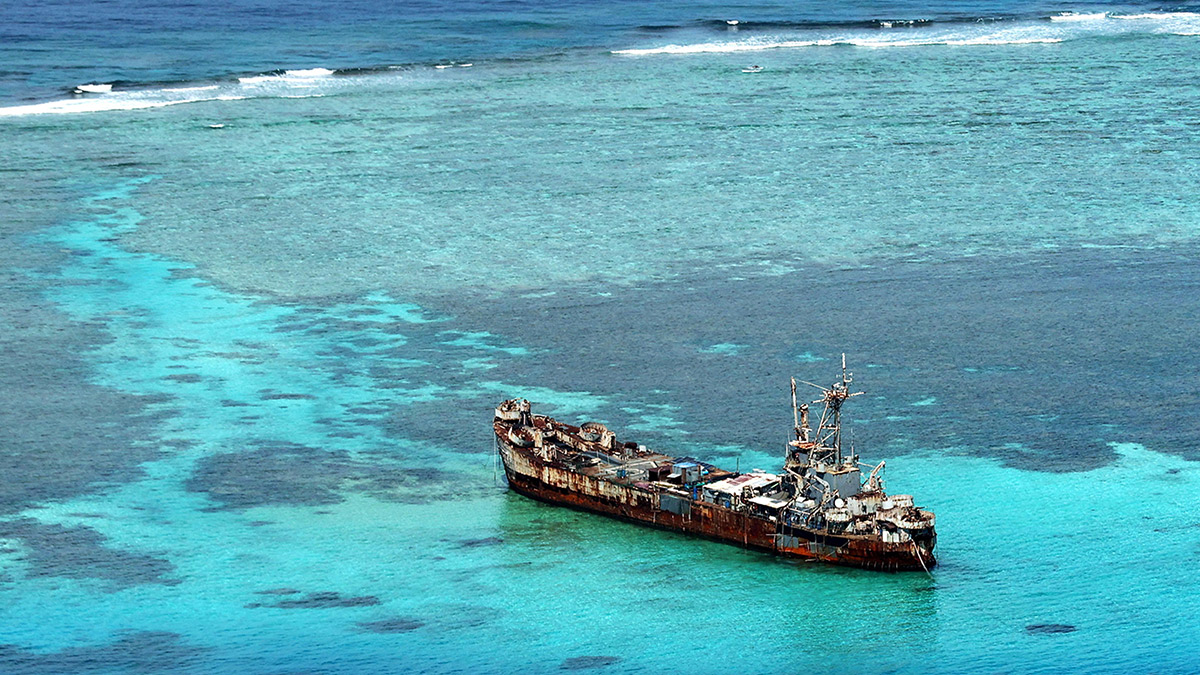West PH Sea: Record 11 China warships spotted in Escoda after BRP Magbanua exit

After Monday’s ramming of a Philippine Coast Guard vessel at Escoda (Sabina) Shoal, concerns over China’s sincerity in keeping regional tensions down shift back to Ayungin (Second Thomas) Shoal, site of the rusting Philippine military outpost, the BRP Sierra Madre. —NIÑO JESUS ORBETA
MANILA, Philippines — The biggest number of Chinese warships to date have been observed in Escoda (Sabina) Shoal in the West Philippine Sea, just over a week after the Philippine Coast Guard pulled out its vessel BRP Teresa Magbanua.
A total of 11 People’s Liberation Army-Navy (PLA-N) were seen in the area from Sept. 17 to 23, Rear Admiral Roy Vincent Trinidad, navy spokesperson for the West Philippine Sea, said on Tuesday.
“This is the first time we have monitored that number [of PLA-N warships] in Sabina,” Trinidad said in a press conference.
Despite this, Trinidad maintained that China does not have a de facto control of the area.
READ: West PH Sea: BRP Teresa Magbanua arrives in Palawan with sick crew
“No. We continue to perform our mandate patrolling by sea and by air, not only in Escoda but in the entire West Philippine Sea,” Trinidad said when asked if the surge of warships meant that China does have de facto control of the shoal.
Security expert Chester Cabalza deemed the unprecedented presence of Chinese warships there as a bid to “enclose the multiple entries” of Escoda Shoal.
“The surge of Chinese warships in Escoda this week can be viewed as a barricade to the Philippines’ assertive rebound,” Cabalza, president and founder of Manila-based think tank International Development and Security Cooperation, told INQUIRER.net on Tuesday.
Cabalza, however, believes that despite this show of force, Beijing could not possibly stop Manila from conducting its patrols there.
“The vastness of geography and climactic change in Escoda would hinder China to secure permanency of its watchdog over the contested atoll,” Cabalza said.
“There are big chances that we could still deploy assets in different coral reef lagoons within Escoda using clever strategies and coordinated tactical operations,” he continued.
Furthermore, Cabalza said he believes that Manila still has a trick up its sleeve to regain its control in Escoda Shoal.
“I believe that our coast guard will surprise its Chinese counterpart since there is a stringent goal to return and protect our maritime features,” he said.
The Philippine Coast Guard (PCG) already deployed a 44-meter vessel to patrol Escoda Shoal, National Security Adviser Eduardo Año said last Friday, but it had to take shelter because of the bad weather.
Trinidad declined to comment when asked for an update on the deployment.
“We usually do not give out details,” Trinidad said. “It’s part of the approach that we have.”
Aside from the PLA-N fleet, 16 China Coast Guard (CCG) ships and 55 Chinese maritime militia vessels were monitored in the area within the said period.
Also, a total of 251 Chinese coast guard ships, warships, and maritime militia vessels were monitored in the West Philippine Sea from Sept. 17 to 23, which is the biggest total so far.
READ: PCG: Replacement ship for Escoda Shoal patrol on the way
After more than five months, the BRP Teresa Magbanua departed Escoda Shoal and arrived at port in Puerto Princesa, Palawan, on September 15. The ship returned with four dehydrated PCG crew members who had subsisted on rice porridge and rainwater for weeks, as the CCG blocked the delivery of supplies.
Escoda Shoal serves as the rendezvous point for Filipino vessels conducting resupply missions to the naval outpost in Ayungin (Second Thomas) Shoal, where the BRP Sierra Madre, a key flashpoint of tensions between Manila and Beijing, has been grounded since 1999.
Beijing’s presence is based on its assertion of sovereignty in almost the entire South China Sea, including most of the West Philippine Sea, even if such a claim has been effectively invalidated by the arbitral award issued in July 2016.
READ: West PH Sea: New Chinese vessels head to Panatag after typhoon evacuation
The landmark ruling stemmed from a case filed by Manila in 2013, a year after its standoff with Beijing at Panatag (Scarborough) Shoal.
For comprehensive coverage, in-depth analysis, visit our special page for West Philippine Sea updates. Stay informed with articles, videos, and expert opinions.


















